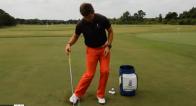Video Menu
My Favorite Videos
My Favorite Videos
Right Knee Downswing Drill
Sorry, you need to be a member to access this video.
You Are Just Seconds Away - Become a member here!
Already a member? Log in now

If you struggle with early extension of your spine in the downswing, hip spinning or even a sore lead hip or knee, this video is perfect for you. I will show you a simple drill that will help overcome some common faults in your downswing and get you striking the ball more solid, more frequently.
- Set an alignment stick up a clubhead width inside your trail foot.
- As you sit into the lead side and begin to clear your hips, try to not allow the trail knee to pass the line.
Hi guys, I'm Rotary Swing Instructor Chris Tyler.
Have you been finding a really difficult time correcting your tush line where you see that your hips are coming forward in your golf swing?
Have you noticed that your right foot or your trail foot is way up off the ground?
Have you also noticed that your right knee is way in over towards your left or your lead leg is out past neutral?
Well, I've got a very, very simple drill today that's going to help you correct a lot of those problems.
Okay guys, So in today's video, I'm going to show you guys a really simple drill that's going to help you overcome a lot of those areas that we struggle with most.
And I know a lot of us want to go out to the range and bash a lot of balls, and if we have a good focus point on how to fix a lot of these things, then in turn, it becomes less frustrating.
And one of the big mistakes that we see from a lot of our golfers is that we tend to drive or push too hard off of that trail leg.
And if you've noticed yourself on camera where you see that your trail foot is way up off the ground here, or if you've noticed that your trail knee is really kind of buckled in here towards your lead leg, maybe your lead leg is out past neutral.
This is a great drill that's going to help you correct a lot of those issues.
And in turn, it's also going to be able to help you maintain your spine angle while you're releasing the club through the hitting area.
So what you want to do here is you're going to go ahead and set yourself up an alignment stick.
And I'm going to do this from a face-on perspective today, but you're going to set yourself up an alignment stick about a club head width inside your trail foot here, okay?
And have it far enough back to where you can still see it out of your peripheral vision here.
So I can see this.
Now what I'm going to be focusing on is when I sit over to my left side, when I'm shifting over to this side, I don't want my knee to move in front of this line.
Okay, that's going to be our focus point is that we don't want to see it going like this.
We don't want to see it going like that.
And I'll show you, I'll turn from down the line here so you can see that.
So this or this.
You want to try your best to keep your trail leg behind this line.
Now it's okay obviously if it does move in front of it when you look at it at full speed, But a good focus point, again, is to try to not allow your right knee or your trail knee to move in front of this line at all, at any part during the swing.
That movement alone, like I said, can cause a lot of your secondary axis tilt problems.
It can cause early extension of the spine.
It can cause you to actually spin your body open.
So try this drill out.
Put an alignment stick in about a width of your club inside your trail foot and focus on.
When you're sitting left and you're releasing the club that you don't want your trail knee to go in front of it.




































































































































































































































































































































































































































































































sean
Chris (Certified RST Instructor)
Matthew
Craig (Certified RST Instructor)
Carole
Craig (Certified RST Instructor)
Tom
Craig (Certified RST Instructor)
Ted
Craig (Certified RST Instructor)
Thomas
Craig (Certified RST Instructor)
Mads
Craig (Certified RST Instructor)
Barbara
Craig (Certified RST Instructor)
Peter
Chris (Certified RST Instructor)
Peter
John
Chris (Certified RST Instructor)
Thomas
Chris (Certified RST Instructor)
randal
Chris (Certified RST Instructor)
randal
Chris (Certified RST Instructor)
terry
Chris (Certified RST Instructor)
jeff
Chris (Certified RST Instructor)
Adam
Craig (Certified RST Instructor)
David
Craig (Certified RST Instructor)
David
Evan
Craig (Certified RST Instructor)
Thomas
Craig (Certified RST Instructor)
Thomas
Michael
Chris (Certified RST Instructor)
Stuart
Chris (Certified RST Instructor)